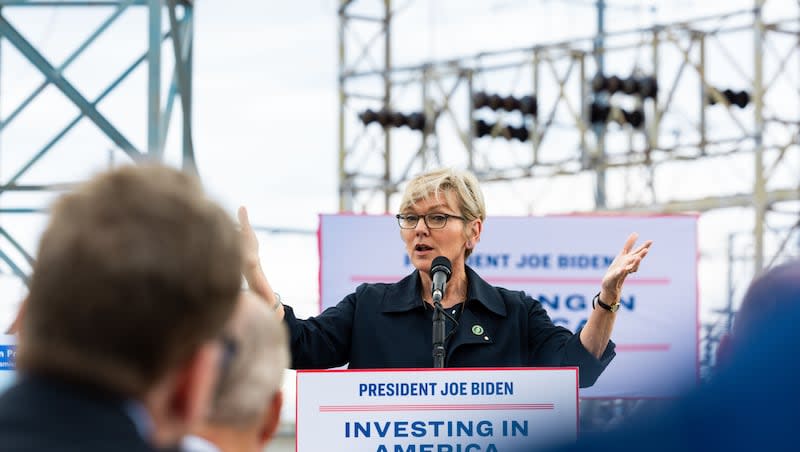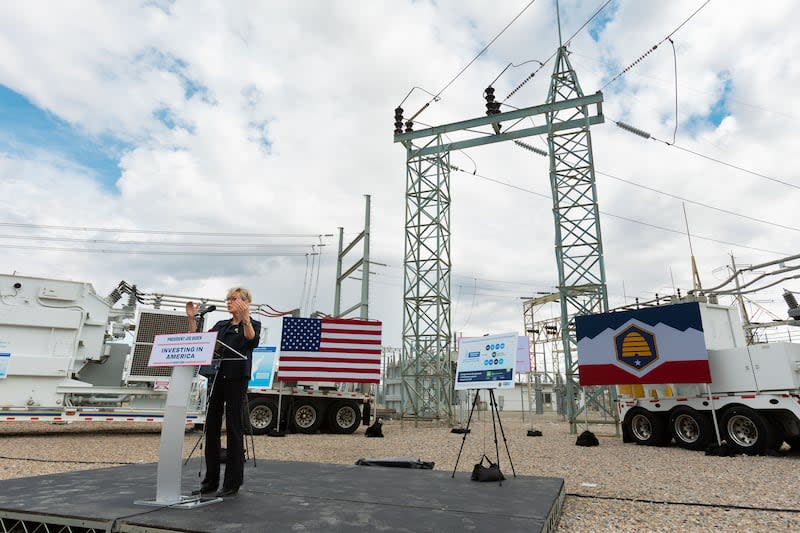Biden administration visits Utah to discuss goal of cheap, reliable electricity

- Oops!Something went wrong.Please try again later.
Department of Energy Secretary Jennifer Granholm traveled to a Rocky Mountain Power substation in South Salt Lake Thursday morning to unveil the Biden administration’s latest efforts to build a more resilient, secure and cleaner electric grid.
“Utah is a powerhouse of a state when it comes to potentially producing, generating clean energy and then getting that energy to move to places where it’s needed and to be able to take energy as well,” Granholm said. Although the scene behind her portrayed a stillness, the tall, tapered-shaped transmission towers actively circulated high-voltage electricity through the taut wires. Granholm says she wants to bolster this grid’s capabilities and connect it to an expanded network in the West.
“Between the geothermal resources that Utah has, the wind and the sun, and now we’ve got all of this commitment to transmission,” she said, hailing the Beehive State as an “instrumental piece of the nation’s infrastructure.”
The biggest challenge to the already overextended grids across the U.S. has been a lengthy permitting process. Grid congestion cost consumers $20.8 billion in 2023, a significant increase from $13.3 billion the previous year, as reported by Grid Strategies in 2023.
Granholm’s visit coincided with the Biden administration’s decision to reform the permitting rule that will shrink the approval time for a transmission line from 10 years to two by consolidating the requirements from different federal agencies and streamlining the review process.
“We want to make transmission better,” said Granholm. This means enhancing technology while adding new lines, wires and miles to the grid. “But all of that requires cooperation with the federal government and that means permitting.”
She said ger department is focused on connecting more communities to power, taking a page out of President Franklin D. Roosevelt’s book. He is hailed for championing the Rural Electrification Act, responsible for providing federal loans to establish an electrical distribution system in the 1930s.
Granholm told the story of a man from this era who wanted to have power in his home but lived outside this distribution wire’s reach. “He did what anybody reasonably would do; He built a new foundation down the road, put his house on logs and just rolled it over to the transmission,” she said jokingly. “Now, we want to do it a little bit differently.”
The energy secretary also announced a series of grants while breaking down the Biden administration’s approach to improving the power system in the Western U.S.
For Utah, specifically, Rocky Mountain Power is receiving $5.7 million to ensure the state has “resilient power” and the “ability to protect against wildfire or extreme weather events,” she said.
Granholm told reporters this will help utility companies install underground transmission lines and cover their conductors, “and that’s what Rocky Mountain Power is doing” as it considers reducing risk while wildfires rise in intensity and frequency.
Joel Ferry, the executive director of the Utah Department of Natural Resources, noted utility companies will also be able to protect themselves against cyber threats by leveraging advanced technologies.
On the state level, the administration is propelling an interconnected web of power lines that allow electrons generated from wind and solar energy to flow from Idaho and Nevada to Utah and California.
“It’s all coming together,” she said, before diving into three transmission line projects moving power across six Western states.

The grid deployment office’s Transmission Facilitation program has $2.5 billion to disperse to developers for setting up new power lines.
The federal government reached a $330 million agreement with Cross-Tie Transmission to connect power from Utah and Nevada, Granholm said.
“We’re particularly excited because that’s going to strengthen the Utah power grid and make sure that you can access resources from all over the West,” Maria Robinson, the director of the grid deployment office told reporters.
This 214-mile line, set to go into service in 2028, will create 4,000 jobs in the Beehive State, and all workers will have to be a part of a labor union, the International Brotherhood of Electrical Workers, for this more than $1 billion project, she added.
Ed Rihn, president and CEO of Berkshire Hathaway Energy Canada, said this project’s construction is expected to generate $760 million for the local economy.
Another $331 million is going toward the Southwest Intertie Project North, bridging power between Idaho and Nevada through a 285-mile line. According to a press release, this will add more than 2,000 megawatts to the grid’s capability and power 2.5 million homes.
Ashley McGeary, the communications director for Grid United, the developer for Southline, told the Deseret News after Granholm’s remarks that transmission lines “cost a lot to construct when they cover so much (area), it can be kind of risky for investors” because a utility company has to get on board to use these lines.
The Department of Energy is “the strongest backer you can ask for,” since it prompts utility companies to sign on to the new lines, she explained.
These transmission lines will connect the Western U.S. and allow electricity to flow wherever needed. “Sometimes it’s so windy in one place, and you want to be able to send that wind elsewhere,” said McGeary.
Ferry, from the Utah Department of Natural Resources, said that the Beehive State doesn’t entirely align with the Biden White House, but that doesn’t take away from the Energy Department’s announcements.
“At the crossroads of the West, Utah is always looking for opportunities. That pioneer spirit exists here in the state of Utah,” said Ferry. “Sometimes the state of Utah and the Biden administration are at odds, but it’s great to be able to come together in terms like this under common goal and common cause.”

